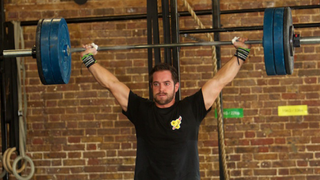The CrossFit Games: everything you need to know
The 8th annual CrossFit Games kick off on the 25th of July. Here's how to enjoy the sport of fitness from your house

Since the annual CrossFit Games were created in 2007 to let devotees of CrossFit - the training methodology that preaches 'constantly varied' workouts full of gymnastics moves, Olympic lifts, heavy lifting and intense cardio - test their training methods, they’ve gone from an open-to-all-comers event held on a ranch to a stadium-based spectator sport that claims to crown the fittest men and women on Earth. But how does it work? Who’s going to win? And are the competitors really that fit? Here’s everything you need to know.
How does the competition work?
It varies - massively. In the first year of the Games, there were three events. In 2009, there were eight, including a hilly 7km trail run and deadlift ladder. In 2012, the event started two days earlier than everyone (including the athletes) thought it would, with an off-road triathlon and a run through a military obstacle course, and finished five days later with a back-to-back run through three of crossfit.com’s signature workouts (Elizabeth, Isabel and Fran, which test everything from pull-ups to snatches). In line with CrossFit’s philosophy of testing the ‘unknown and unknowable’, nobody apart from the organisers know in advance what the events will be… or even how many there are.
Okay, so how does the scoring work?
This is slightly easier. In every event, the first-placed athlete (ie the one who finishes fastest, lifts the most weight or gets the most reps) gets one point, the second-placed one gets two points and so on. The lowest points total wins, but it’s also important to remember that you can’t afford to do too badly in the early workouts and try to make up ground later, because the worst-scoring athletes are eliminated at various stages of the competition.
So how do they get there in the first place?
There are two preliminary qualifying stages. First is the Open, where anyone who wants to can video themselves doing a series of five weekly workouts (adhering to strict judging standards) or do them at their local CrossFit gym. The top scorers are invited to one of 17 Regional competitions, where they do a succession of much harder workouts over a long weekend. The top three finishers in each region get an invitation to the Games.
Get the Coach Newsletter
Sign up for workout ideas, training advice, reviews of the latest gear and more.
Right. Who’s going to win then?
You’d be mad to bet against Rich Froning, who’s won for the past three years in a row, reportedly trains three or four times a day, and says this year might well be his last in the individual competition. But it’s also worth watching out for crowd favourites Jason Khalipa and Chris Spealler. The former won in 2009, while the latter continues to defy the odds by doing well despite being the lightest man in the competition by far.
And are they really the fittest people in the world?
It depends on your definition of fitness. CrossFit’s is ‘increased work capacity across broad time and modal domains’ and according to that, yes, they probably are. To put things in perspective, Froning squats 200kg, deadlifts 250kg, can do 75 'butterfly' pullups in a row (more on that in a second) and rowed a 6min 34sec 2km in the 2013 competition.
The main criticism of CrossFit’s programming is that certain high-skill exercises - such as those butterfly pull-ups, Olympic lifts and skipping double-unders – exclude anyone who doesn’t practise them from the competition, so you’re unlikely to see any Olympians or NFL players competing in the near future. Sometimes even the champs can fall foul of this - defending women’s champ Samantha Briggs won three events at the Regionals, but won’t be in the Games because she did so badly on the ‘handstand walk’ event. But realistically: anyone who's even at the Games is probably stronger, faster and better at pull-ups than the fittest person in your gym.
OK, I’m sold. How do I watch it?
For free! It’s live at games.crossfit.com and, barring any 2013-style surprises, the men and women’s competitions start on Friday 25th July, although the masters and team competitions are running all week. And if you’ve got a hankering to compete next year, check out our guide on how to win. You should probably start now.
From 2008 to 2018, Joel worked for Men's Fitness, which predated, and then shared a website with, Coach. Though he spent years running the hills of Bath, he’s since ditched his trainers for a succession of Converse high-tops, since they’re better suited to his love of pulling vans, lifting cars, and hefting logs in a succession of strongman competitions.

